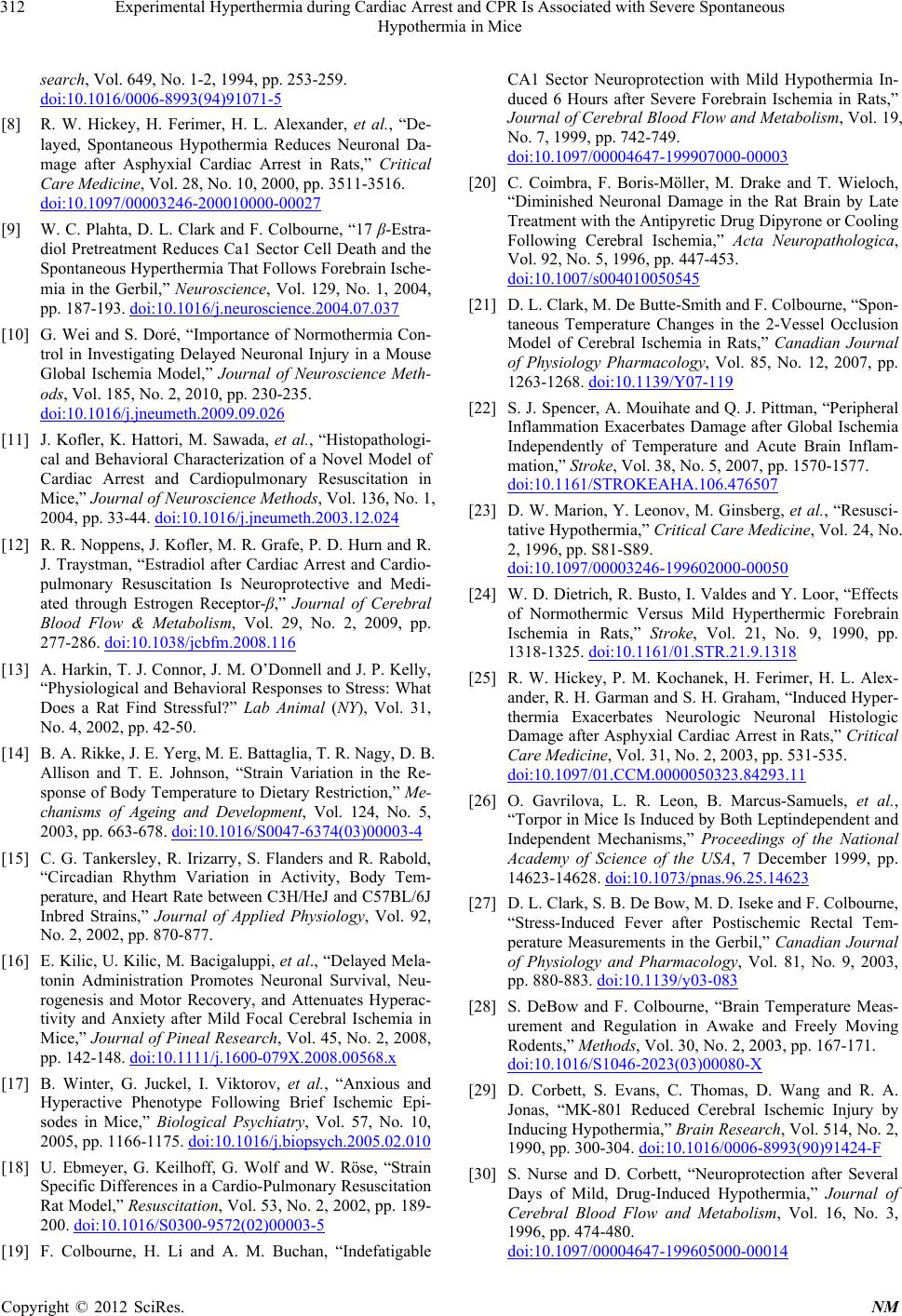
Experimental Hyperthermia during Cardiac Arrest and CPR Is Associated with Severe Spontaneous
Hypothermia in Mice
312
search, Vol. 649, No. 1-2, 1994, pp. 253-259.
doi:10.1016/0006-8993(94)91071-5
[8] R. W. Hickey, H. Ferimer, H. L. Alexander, et al., “De-
layed, Spontaneous Hypothermia Reduces Neuronal Da-
mage after Asphyxial Cardiac Arrest in Rats,” Critical
Care Medicine, Vol. 28, No. 10, 2000, pp. 3511-3516.
doi:10.1097/00003246-200010000-00027
[9] W. C. Plahta, D. L. Clark and F. Colbourne, “17 β-Estra-
diol Pretreatment Reduces Ca1 Sector Cell Death and the
Spontaneous Hyperthermia That Follows Forebrain Ische-
mia in the Gerbil,” Neuroscience, Vol. 129, No. 1, 2004,
pp. 187-193. doi:10.1016/j.neuroscience.2004.07.037
[10] G. Wei and S. Doré, “Importance of Normothermia Con-
trol in Investigating Delayed Neuronal Injury in a Mouse
Global Ischemia Model,” Journal of Neuroscience Meth-
ods, Vol. 185, No. 2, 2010, pp. 230-235.
doi:10.1016/j.jneumeth.2009.09.026
[11] J. Kofler, K. Hattori, M. Sawada, et al., “Histopathologi-
cal and Behavioral Characterization of a Novel Model of
Cardiac Arrest and Cardiopulmonary Resuscitation in
Mice,” Journal of Neuroscience Methods, Vol. 136, No. 1,
2004, pp. 33-44. doi:10.1016/j.jneumeth.2003.12.024
[12] R. R. Noppens, J. Kofler, M. R. Grafe, P. D. Hurn and R.
J. Traystman, “Estradiol after Cardiac Arrest and Cardio-
pulmonary Resuscitation Is Neuroprotective and Medi-
ated through Estrogen Receptor-β,” Journal of Cerebral
Blood Flow & Metabolism, Vol. 29, No. 2, 2009, pp.
277-286. doi:10.1038/jcbfm.2008.116
[13] A. Harkin, T. J. Connor, J. M. O’Donnell and J. P. Kelly,
“Physiological and Behavioral Responses to Stress: What
Does a Rat Find Stressful?” Lab Animal (NY), Vol. 31,
No. 4, 2002, pp. 42-50.
[14] B. A. Rikke, J. E. Yerg, M. E. Battaglia, T. R. Nagy, D. B.
Allison and T. E. Johnson, “Strain Variation in the Re-
sponse of Body Temperature to Dietary Restriction,” Me-
chanisms of Ageing and Development, Vol. 124, No. 5,
2003, pp. 663-678. doi:10.1016/S0047-6374(03)00003-4
[15] C. G. Tankersley, R. Irizarry, S. Flanders and R. Rabold,
“Circadian Rhythm Variation in Activity, Body Tem-
perature, and Heart Rate between C3H/HeJ and C 57BL/ 6J
Inbred Strains,” Journal of Applied Physiology, Vol. 92,
No. 2, 2002, pp. 870-877.
[16] E. Kilic, U. Kilic, M. Bacigaluppi, et al., “Delayed Mela-
tonin Administration Promotes Neuronal Survival, Neu-
rogenesis and Motor Recovery, and Attenuates Hyperac-
tivity and Anxiety after Mild Focal Cerebral Ischemia in
Mice,” Journal of Pineal Research, Vol. 45, No. 2, 2008,
pp. 142-148. doi:10.1111/j.1600-079X.2008.00568.x
[17] B. Winter, G. Juckel, I. Viktorov, et al., “Anxious and
Hyperactive Phenotype Following Brief Ischemic Epi-
sodes in Mice,” Biological Psychiatry, Vol. 57, No. 10,
2005, pp. 1166-1175. doi:10.1016/j.biopsych.2005.02.010
[18] U. Ebmeyer, G. Keilhoff, G. Wolf and W. Röse, “Strain
Specific Differences in a Cardio-Pulmonary Resuscitation
Rat Model,” Resuscitation, Vol. 53, No. 2, 2002, pp. 189-
200. doi:10.1016/S0300-9572(02)00003-5
[19] F. Colbourne, H. Li and A. M. Buchan, “Indefatigable
CA1 Sector Neuroprotection with Mild Hypothermia In-
duced 6 Hours after Severe Forebrain Ischemia in Rats,”
Journal of Cerebral Blood Flow and Metabolism, Vol. 19,
No. 7, 1999, pp. 742-749.
doi:10.1097/00004647-199907000-00003
[20] C. Coimbra, F. Boris-Möller, M. Drake and T. Wieloch,
“Diminished Neuronal Damage in the Rat Brain by Late
Treatment with the Antipyretic Drug Dipyrone or Cooling
Following Cerebral Ischemia,” Acta Neuropathologica,
Vol. 92, No. 5, 1996, pp. 447-453.
doi:10.1007/s004010050545
[21] D. L. Clark, M. De Butte-Smith and F. Colbourne, “Spon-
taneous Temperature Changes in the 2-Vessel Occlusion
Model of Cerebral Ischemia in Rats,” Canadian Journal
of Physiology Pharmacology, Vol. 85, No. 12, 2007, pp.
1263-1268. doi:10.1139/Y07-119
[22] S. J. Spencer, A. Mouihate and Q. J. Pittman, “Peripheral
Inflammation Exacerbates Damage after Global Ischemia
Independently of Temperature and Acute Brain Inflam-
mation,” Stroke, Vol. 38, No. 5, 2007, pp. 1570-1577.
doi:10.1161/STROKEAHA.106.476507
[23] D. W. Marion, Y. Leonov, M. Ginsberg, et al., “Resusci-
tative Hypothermia,” Critical Care Medicine, Vol. 24, No.
2, 1996, pp. S81-S89.
doi:10.1097/00003246-199602000-00050
[24] W. D. Dietrich, R. Busto, I. Valdes and Y. Loor, “Effects
of Normothermic Versus Mild Hyperthermic Forebrain
Ischemia in Rats,” Stroke, Vol. 21, No. 9, 1990, pp.
1318-1325. doi:10.1161/01.STR.21.9.1318
[25] R. W. Hickey, P. M. Kochanek, H. Ferimer, H. L. Alex-
ander, R. H. Garman and S. H. Graham, “Induced Hyper-
thermia Exacerbates Neurologic Neuronal Histologic
Damage after Asphyxial Cardiac Arrest in Rats,” Critical
Care Medicine, Vol. 31, No. 2, 2003, pp. 531-535.
doi:10.1097/01.CCM.0000050323.84293.11
[26] O. Gavrilova, L. R. Leon, B. Marcus-Samuels, et al.,
“Torpor in Mice Is Induced by Both Leptindependent and
Independent Mechanisms,” Proceedings of the National
Academy of Science of the USA, 7 December 1999, pp.
14623-14628. doi:10.1073/pnas.96.25.14623
[27] D. L. Clark, S. B. De Bow, M. D. Iseke and F. Colbourne,
“Stress-Induced Fever after Postischemic Rectal Tem-
perature Measurements in the Gerbil,” Canadian Journal
of Physiology and Pharmacology, Vol. 81, No. 9, 2003,
pp. 880-883. doi:10.1139/y03-083
[28] S. DeBow and F. Colbourne, “Brain Temperature Meas-
urement and Regulation in Awake and Freely Moving
Rodents,” Methods, Vol. 30, No. 2, 2003, pp. 167-171.
doi:10.1016/S1046-2023(03)00080-X
[29] D. Corbett, S. Evans, C. Thomas, D. Wang and R. A.
Jonas, “MK-801 Reduced Cerebral Ischemic Injury by
Inducing Hypothermia,” Brain Research, Vol. 514, No. 2,
1990, pp. 300-304. doi:10.1016/0006-8993(90)91424-F
[30] S. Nurse and D. Corbett, “Neuroprotection after Several
Days of Mild, Drug-Induced Hypothermia,” Journal of
Cerebral Blood Flow and Metabolism, Vol. 16, No. 3,
1996, pp. 474-480.
doi:10.1097/00004647-199605000-00014
Copyright © 2012 SciRes. NM